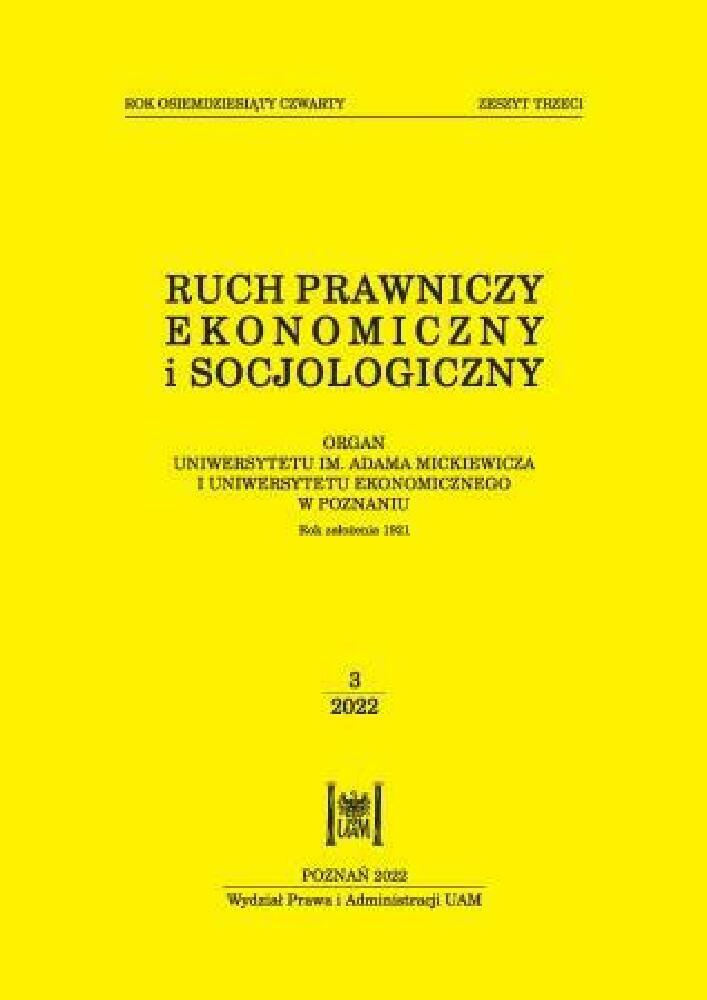Abstrakt
Celem badawczym artykułu jest ocena wpływu zmian składu indeksu WIG20 na stopy zwrotu akcji spółek włączanych i wykluczanych ze składu tego indeksu. Analiza została przeprowadzona w kilku wariantach dla okresu obejmującego lata 2000–2020. W celu sprawdzenia stabilności w czasie obserwowanych zależności okres badawczy podzielony został na dwa podokresy: 2000–2009 i 2010–2020. Badania zrealizowano, opierając się na analizie zdarzeń, z wykorzystaniem testów parametrycznych. Przedmiotem badania były krótkoterminowe ponadnormatywne stopy zwrotu z akcji spółek wprowadzanych i wycofywanych z indeksu. Weryfikacji poddano następujące hipotezy badawcze: H1. Włączenie spółek w skład indeksu WIG20 pozytywnie wpływa na nadwyżkową stopę zwrotu ich akcji, oraz H2. Usunięcie spółek ze składu indeksu WIG20 negatywnie wpływa na nadwyżkową stopę zwrotu ich akcji. Uzyskane wyniki potwierdzają występowanie dodatniego efektu cenowego wywołanego wprowadzeniem spółek do indeksu. W przypadku usunięcia spółek z indeksu w badaniu nie odnotowano istotnego statystycznie efektu indeksowego. Wskazuje to na pewną obserwowaną specyfikę polskiego rynku: wyraźną asymetrię w reakcjach mierzonych nadwyżkowymi stopami zwrotu na wprowadzenie i usunięcie spółek z indeksu. Przeprowadzone badania uzupełniają dostępne wyniki na temat efektów indeksowych występujących podczas rewizji indeksów giełdowych na rynkach wschodzących.
Finansowanie
University of Lodz
Bibliografia
Afego, P.N. (2017). Effects of changes in stock index compositions: a literature survey. International Review of Financial Analysis 52: 228–239.
Bennett, B., Stulz, R.M., Wang, Z. (2020). Does joining the S&P 500 Index hurt firms? ECGI Working Paper Series in Finance 690/2020.
Biktimirov, E.N., Li, B. (2014). Asymmetric stock price and liquidity responses to changes in the FTSE SmallCap index. Review of Quantitative Finance and Accounting 42: 95–122.
Brown, S.J., Warner, J.B. (1985). Using daily stock returns: the case of event studies. Journal of Financial Economics 14: 3–31.
Chan, K., Kot, H.W., Tang, G.Y. (2013). A comprehensive long-term analysis of S&P 500 index additions and deletions. Journal of Banking & Finance 37(12): 4920–4930.
Chen, H.L. (2006). On Russell index reconstitution. Review of Quantitative Finance and Accounting 26(4): 409–430.
Chen, H., Noronha, G., Singal, V. (2004). The price response to S&P 500 index additions and deletions: evidence of asymmetry and a new explanation. The Journal of Finance 59(4): 1901–1930.
Daya, W., Mazouz, K., Freeman, M. (2012). Information efficiency changes following FTSE 100 index revisions. Journal of International Financial Markets Institutions and Money 22(4): 1054–1069.
Deininger, C.G., Kaserer, C., Roos, S. (2020). Stock price effects associated with index replacements in Germany. <https://ssrn.com/abstract=264570>.
Denis, D.K., McConnell, J.J., Ovtchinnikov, A.V., Yu, Y. (2003). S&P 500 index additions and earnings expectations. The Journal of Finance 58(5): 1821–1840.
Dyckman, T., Philbrick D., Stephan, J. (1984). A comparison of event study methodologies using daily stock returns: a simulation approach. Journal of Accounting Research 22(Supplement): 1–30.
Fama, E.F. (1965). The behavior of stock-market prices. The Journal of Business 38(1): 55–59.
Fernandes, M., Mergulhão, J. (2016). Anticipatory effects in the FTSE 100 index revisions. Journal of Empirical Finance 37: 79–90.
Gurgul, H. (2019). Analiza zdarzeń na rynkach akcji. Wpływ informacji na ceny papierów wartościowych. Warszawa: Wyd. Nieoczywiste.
Hacibedel, B., Bommel, J. van (2007). Do emerging markets benefit from index inclusion? Money Macro and Finance (MMF) Research Group conference 2006 (no. 128). Money Macro and Finance Research Group. <http://repec.org/mmf2006/up.16680.1145726171.pdf>.
Harris, L., Gurel, E. (1986). Price and volume effects associated with changes in the S&P 500 list: New evidence for the existence of price pressures. The Journal of Finance 41(4): 815–829.
Hońdo, T. (2010). Wejście do WIG20 to powód do sprzedaży akcji? Gazeta Giełdy Parkiet 30.08.2010. <https://www.parkiet.com/analizy-rynkowe/art23299411-wejscie-do-wig20-to-powod-do-sprzedazy-akcji>.
Izbrandt, M. (2016). Efekt indeksowy – analiza indeksu WIG20. Debiuty Ekonomiczne 17: 103–116.
Jain, P. (1987). The effect on stock price of inclusion or exclusion from the S&P 500. Financial Analysts Journal 43: 58–65.
Kamal, R. (2014). New evidence from S&P 500 Index deletions. The International Journal of Business and Finance Research 8(2): 1–10.
Kamal, R., Lawrence, E.R., McCabe, G., Prakash, A.J. (2012). Additions to S&P 500 Index: not so informative any more. Managerial Finance 38(4): 380–402.
Liu, S. (2006). The impacts of index rebalancing and their implications: some new evidence from Japan. Journal of International Financial Markets Institutions and Money 16(3): 246–269.
Mazouz, K., Saadouni, B. (2007). The price effects of FTS 100 index revision: what drives the long-term abnormal return reversal? Applied Financial Economics 17: 501–510.
Merton, R.C. (1987). A simple model of capital market equilibrium with incomplete information. The Journal of Finance 42(3): 483–510.
Miller, C., Ward, M. (2015). Themarket impact on shares entering or leaving JSE indices. Investment Analysts Journal 44(1): 84–101.
Miziołek, T. (2016). Wpływ publikacji informacji o wykluczeniu spółek z indeksu WIG20 na ich stopę zwrotu, [w:] T. Czerwińska, A.Z. Nowak (red.), Rynek kapitałowy – efektywność i ryzyko. Warszawa: Wydawnictwo Naukowe Wydziału Zarządzania Uniwersytetu Warszawskiego: 74–86.
Petajisto, A. (2008). Selection of an optimal index rule for an index fund. doi: https://www.doi.org/10.2139/ssrn.1264698
Peterson, P.P. (1989). Event studies: a review of issues and methodology. Quarterly Journal of Business and Economics 28(3): 36–66.
Platikanova, P. (2008). Long-term price effect of S&P 500 addition and earnings quality. Financial Analysts Journal 64(5): 62–76.
Pullen, D., Gannon, G. (2007). The index effect: an investigation of the price, volume and trading effects surrounding changes to the S&P Australian Indices (no. 2007_07). Deakin University, Faculty of Business and Law, School of Accounting, Economics and Finance.
Scholes, M.S. (1972). The market for securities: Substitution versus price pressure and the effects of information on share prices. The Journal of Business 45(2): 179–211.
Shleifer, A. (1986). Do demand curves for stocks slope down? The Journal of Finance 41(3): 579–590.
Vespro, C. (2006). Stock price and volume effects associated with compositional changes in European stock indices. European Financial Management 12(1): 103–127.
Wang, C., Murgulov, Z., Haman, J. (2015). Impact of changes in the CSI 300 index constituents. Emerging Markets Review 24: 13–33.
Wiśniewski, T. (2002). Zmiany portfela WIG20. Nasz Rynek Kapitałowy 133(1): 80–88.
Licencja
Prawa autorskie (c) 2022 WPiA UAM

Utwór dostępny jest na licencji Creative Commons Uznanie autorstwa – Użycie niekomercyjne – Bez utworów zależnych 4.0 Międzynarodowe.





